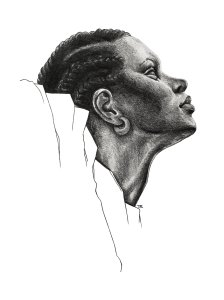- Practice sitting or walking meditation as many times this week as you can, for at least 10 or 15 minutes at a time. You might remind yourself that learning how to be present to yourself is a beautiful foundation for being truly present for others. For support in your sitting practice, you might check out these 8 Essential Tips for Practice from Tara Brach.
- When you find yourself in conversation this week, invite yourself to deepen your listening. You might remind yourself before you sit down for dinner or call a friend: listening is an act of love.
- Enjoy this excerpt from Tara Brach’s book, True Refuge, in which she tells the story of a woman who transformed her very difficult relationship with her mother through deep listening.
Author Archives: Teresa Jordan
The Art of Listening—a poem
The Art of Listening
by Jonathan Drane
I knew something of conversation, or so I thought
until I listened to another.
Knew something of the talk, the sounds the chatter,
But to listen and to speak when moments call,
that is far greater.
Of conversations past, I no longer can remember,
Since the day I silent kept- and listened to another,
There opened up a life which had ‘til then
been merely shadow
At first the life it seemed another’s, but when I was caught
and by the mirror
The face had changed, it told me of another.
Since the day I silent kept- and listened to another.
Published on poemhunter.com
On listening…
“I Happened To Be Standing” by Mary Oliver
I don’t know where prayers go,
or what they do.
Do cats pray, while they sleep
half-asleep in the sun?
Does the opossum pray as it
crosses the street?
The sunflowers? The old black oak
growing older every year?
I know I can walk through the world,
along the shore or under the trees,
with my mind filled with things
of little importance, in full
self-attendance. A condition I can’t really
call being alive.
Is a prayer a gift, or a petition,
or does it matter?
The sunflowers blaze, maybe that’s their way.
Maybe the cats are sound asleep. Maybe not.
While I was thinking this I happened to be standing
just outside my door, with my notebook open,
which is the way I begin every morning.
Then a wren in the privet began to sing.
He was positively drenched in enthusiasm,
I don’t know why. And yet, why not.
I wouldn’t pursuade you from whatever you believe
or whatever you don’t. That’s your business.
But I thought, of the wren’s singing, what could this be
if it isn’t a prayer?
So I just listened, my pen in the air.
The Calming Power of Ritual
 An article in yesterday’s New York Times, “Rituals Keep These Athletes Grounded. They Can Help Parents, Too,” offers advice that is as relevant to meditators as it is to athletes and parents. (If you can’t access the article online, you can access a pdf here.)
An article in yesterday’s New York Times, “Rituals Keep These Athletes Grounded. They Can Help Parents, Too,” offers advice that is as relevant to meditators as it is to athletes and parents. (If you can’t access the article online, you can access a pdf here.)
“Rituals allow you to create a pathway to connect your mind and body and feel in control during a time where there are a lot of unknowns,” said Caroline Silby, Ph.D., a sports psychology expert for professional athletes, including the United States figure skating team. She said once that connection is made, we are “more empowered to respond and make effective choices.”
…. Before every free throw, [Kevin Love of the Cleveland Cavaliers] dribbles the ball three times and waits an extra beat before shooting — a ritual he finds to be “super grounding” and a way to find focus.
Few of us will find ourselves aiming a free throw in a championship game, but the ability to access calm and focus serves us whenever we are faced with stress or conflict – in a family spat, for instance, or cutoff by some jerk in traffic. In those cases, we can’t actually do the ritual, but if we have firmly established it, just calling it to mind will help bring calm and clarity to a moment of stress.
Here are some suggestions. Adapt these or invent others to make your ritual entirely your own. Continue reading
Mindful of Race on Independence Day
 Like many from the dominant culture, I thought I had an understanding of racism. I have a degree in history and I thought I knew something about the civil war, the evils of slavery, and it’s lasting legacy of pain. But the events of the past few months have opened my eyes to how little I truly understood about the deep history of racism and the infinite ways in which its pervasive virulence continues to wound the world.
Like many from the dominant culture, I thought I had an understanding of racism. I have a degree in history and I thought I knew something about the civil war, the evils of slavery, and it’s lasting legacy of pain. But the events of the past few months have opened my eyes to how little I truly understood about the deep history of racism and the infinite ways in which its pervasive virulence continues to wound the world.
A major reason we practice mindfulness is to reduce suffering, our own and that of other people. In a recent talk, Jack Kornfield suggested that we individually commit to awakening around racial injustice. He vowed to mention race in each of his talks. My own commitment is to educate myself and to share what I find most helpful.
The 4th of July, that day we are reminded of the unfulfilled hope of our founding promise that all people are created equal, seems a particularly apt day to begin this sharing, and the poet Carol Randall Williams’s recent op-ed in the New York Times–”You Want a Confederate Monument? My Body Is a Confederate Monument“–is a good place to start. (If you can’t access this on the New York Times site, you can read a pdf here.)
Some excerpts: Continue reading
Invitations: Lovingkindness
Art of Communication Week 1: Lovingkindness
- Review the practice of lovingkindness by watching this short, 7-minute video that takes you through the expanding circles of compassion with humor and poetry. Remember that you don’t need to practice for each circle every time. Especially in the beginning, you might want to offer lovingkindness to yourself and/or a beloved friend or mentor. In time you can expand those offerings to a neutral person, a difficult person, and all beings.
- Do a lovingkindness meditation at least once or twice this week. If you don’t have a lot of experience, guided meditations are invaluable. You can access a written script by Jack Kornfield here. You can access a selection of recorded guided meditations here, or by clicking on the Meditations tab in the top menu.
- If you find yourself addicted to the news, consider stopping for a few moments before you click on Facebook or a news site and offering yourself and others phrases of lovingkindness. Invite yourself to feel the experience of loving and of being loved in every cell of your body. Rest in this awareness. Perhaps you will decide to put off the “horror scrolling” for another time.
- You might want to find three or four short phrases that feel particularly tailored to you right now, such as “May I be loving; may I be loved; may I be able to receive love in the ways it is offered.” Or, try the phrases below from Jon Kabat Zinn. Call on them whenever you are feeling stressed.
May I be happy
May I be healthy
May I ride the waves of my life
May I live in peace
No matter what I am givenMay you be happy
May you be healthy
May your ride the waves of your life
May you live in peace
No matter what you are givenMay we be happy
May we be healthy
May we ride the waves of our lives
May we live in peace
No matter what we are given.
Metta in Poems and Laughter
This darling video on metta or lovingkindness is as profound as it is sweet (and yes, I have reached an age where I can call something darling without apology, especially when done by darling, brilliant, loving young people.)

Manidha and Alice in Seattle prepared this 7-minute video for a 2013 retreat sponsored by the Buddhist Centre Online. They talk about the five circles of lovingkindness — for self, a loved one, a neutral person, a difficult person, and for all beings — and share a poem for each one. You can watch it here.
The poems are drawn from the book Love Poems from God: Twelve Sacred Voices from the East and West, compiled and interpreted by Daniel Ladinsky. Here is one of them, by the German theologian, philosopher and mystic, Meister Eckhart:
LOVE DOES THAT
by Meister Eckhart
All day long a little burro labors, sometimes
with heavy loads on her back and sometimes just with worries
about things that bother only
burros.
And worries, as we know, can be more exhausting
than physical labor.
Once in a while a kind monk comes
to her stable and brings
a pear, but more
than that,
he looks into the burro’s eyes and touches her ears
and for a few seconds the burro is free
and even seems to laugh, because love does
that.
Love frees.
— Meister Eckhart, born c. 1260 AD
A Poem of Lovingkindness
LOVE DOES THAT
by Meister Eckhart
All day long a little burro labors, sometimes
with heavy loads on her back and sometimes just with worries
about things that bother only
burros.
And worries, as we know, can be more exhausting
than physical labor.
Once in a while a kind monk comes
to her stable and brings
a pear, but more
than that,
he looks into the burro’s eyes and touches her ears
and for a few seconds the burro is free
and even seems to laugh, because love does
that.
Love frees.
The Anti-Racism Revolution: Inhabiting the Moment
A CONVERSATION BETWEEN SPRING WASHAM AND TARA BRACH
Saturday, July 11, 1 -2 pm EDT, offered through the Zoom platform online
-2 pm EDT, offered through the Zoom platform online
This is an online event worth considering. You can learn more about it and register here. Continue reading
Another gift to mark Juneteenth
This incredible offering from Rhiannon Giddens, featuring Yo-Yo Ma. You can see it full screen on YouTube.
[youtube https://www.youtube.com/watch?v=gYDo0ZjXegM]
About “Build A House,” Ms. Giddens wrote: “This song came knocking about a week ago and I had to open the door and let it in. What can I say about what’s been happening, what has happened, and what is continuing to happen, in this country, in the world? There’s too many words and none, all at once. So I let the music speak, as usual. What a thing to mark this 155th anniversary of Juneteenth with that beautiful soul Yo-Yo Ma. Honored to have it out in the world.”
LYRICS: Build a House
